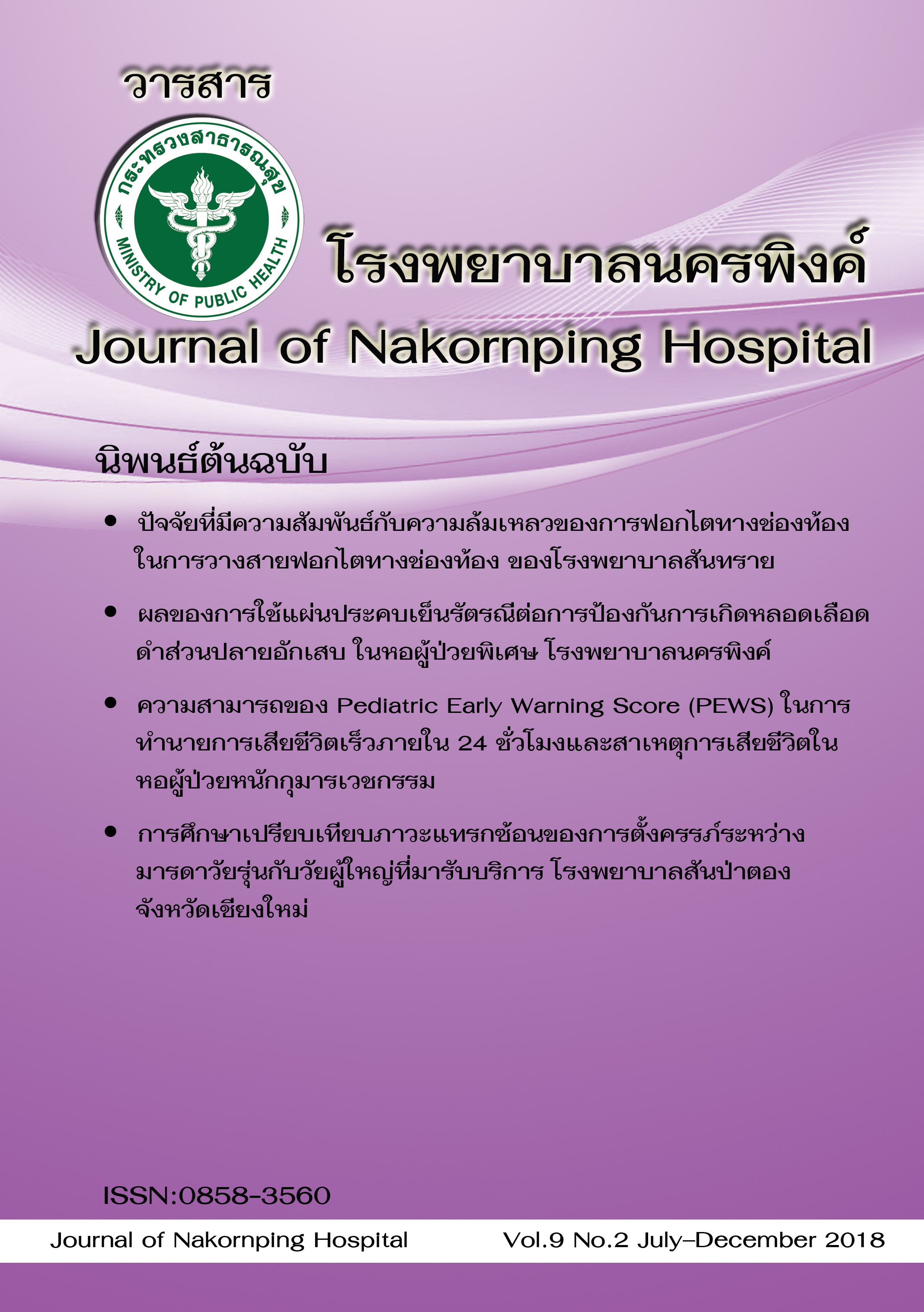Patency of Peritoneal dialysis in Sansai Hospital
Abstract
End stage renal disease is an important health problem in Thailand. After the peritoneal dialysis is in the universal health care coverage. The study found that the surgery to peritoneal dialysis catheter insertion are further increased amounts and also higher rate of peritonitis as well. Resulting in a failure in hemodialysis, followed by surgery statistics from San Sai Hospital found that the rate of dialysis failure is 1 in 3 of the patients underwent surgery, the researcher has the idea that it should be reviewed for various factors. That affects the failure of peritoneal dialysis to find a way to reduce the incidence to a minimum.
Research methodology: Retrospective cohort study. Comparison of factors related to failure of peritoneal dialysis. By collecting data from medical records of the patients who underwent surgery at San Sai hospital From February 2014 to September 2016
Results: The study found that the patients with peritoneal dialysis failed are 25 cases, from total 100 sample.
As reveal the general characteristics of the population and intra-operative finding such as surgical incision, history of abdominal surgery, ascites problem, dialysis flow rate and position of the dialysis catheter. There was no statistically significant difference between two groups. But for the data obtained post-surgery found that, Peritonitis is a factor that has a statistically significant difference (P-value = 0.001). Which, when analyzed with Multiple logistic regression, Patients with history of abdominal surgery and Peritonitis are statistically significantly increased incident of failure in peritoneal dialysis (OR 4.48-119.11 ,P-value = 0.001 and OR 1.09-22.56 ,P-value = 0.038). Especially peritonitis also reduces the survival rate of patients (OR 1.05-6.77 ,P-value = 0.039).
Conclusion: This study therefore suggests important correlating factors affecting renal dialysis failure. That is, patients who had undergone abdominal surgery and abdominal infection. Therefore, doctors and nurses should give importance to providing knowledge and understanding Allow the patient to take care of the dialysis line correctly and should follow up closely.
References
2. Akoh AJ. Peritoneal dialysis associated infection: An update on diagnosis and management. World J Nephrol 2012;1(4): 106-122
3. โรงพยาบาลสันทราย. สถิติห้องผ่าตัด.เชียงใหม่: โรงพยาบาลสันทราย; 2561
4. โรงพยาบาลสันทราย. สถิติหน่วยบริการไตเทียม.เชียงใหม่: โรงพยาบาลสันทราย; 2561
5. Bunke CM, Brier ME, Golper TA. Outcomes of single organism peritonitis in peritoneal dialysis:gram negatives versus gram positives in the Network 9 Peritonitis Study. Kidney Int 1997; 52:524-9.
6. Li PK, Szeto CC, Piraino B, Bernardini J, Figueiredo AE, Gupta A, Johnson DW, Kuijper EJ, Lye WC, Salzer W, SchaeferF, Struijk DG. Peritoneal dialysis-related infections recommendations: 2010 update. Perit Dial Int 2010; 30: 393-423
7. Fried LF, Bernardini J, Johnston JR, Piraino B. Peritonitis influences mortality in peritoneal dialysis patients. J Am Soc Nephrol 1996; 7: 2176-82.
8. Teixeira JP, Combs SA, Teitelbaum I. Peritoneal dialysis: update on patient survival. Clinical Nephrology, 2015; 3(1):1-10
9. Churchill DN, Thorpe KE, Nolph KD, et al. Increased peritoneal membrane transport is associated with decreased patient and technique survival for continuous peritoneal dialysis patients. The Canada-USA (CANUSA) Peritoneal Dialysis Study Group. J Am Soc Nephrol.1998;9:1285–1292.
10. Hung KY, Lin TJ, Tsai TJ, Chen WY. Impact of peritoneal membrane transport on technique failure and patient survival in a population on automated peritoneal dialysis. ASAIO J. 1999;45:568–573.
11. Chung SH, Chu WS, Lee HA, et al. Peritoneal transport characteristics, comorbid diseases and survival in CAPD patients. Perit Dial Int. 2000;20:541–547.
12. Unal A, Sipahioglu MH, Kocyigit I, Tunca O, Tokgoz B, Oymak O. Risk factor(s) related to high membrane permeability in peritoneal dialysis. Renal failure 2016;38(2):238-41
13. Guo A, Mujais S. Patient and technique survival on peritoneal dialysis in the United States: evaluation in large incident cohort. Kidney Int Suppl. 2003;(88):S3-12.
14. Sangshaisirisakd U. Cause of early and late catheter failure and death on CAPD under Univerasal coverage program. Sawanpracharak medical journal 2010;7(1):13-20
15. Lin JJ, Wadhwa NK, Suh H, et al. Increased peritoneal solute transport in diabetic peritoneal dialysis patients. Adv Perit Dial. 1995;11:63–66.
16. J.R. Li, C.H. Chen, K.Y. Chiu, C.R. Yang, C.L. Cheng, Y.C. Ou, J.L. Ko,2 and H.C. Ho1. Management of Pericannular Bleeding after Peritoneal Dialysis Catheter Placement. Perit Dial Int. 2012; 32(3): 361–362.
17. OktayBanli,HasanAltun,AysegulOztemel. EARLY START OF CAPD WITH THE SELDINGER TECHNIQUE. Peritoneal Dialysis International. 2005;25(6): 556–559
18. JH Crabtree. Selected best demonstrated practices in peritoneal dialysis access. Kidney International. 2006;70, S27–S37.
19. PM Dogra, AK Hooda, G Shanmugraj, S Kumar. Peritoneal dialysis catheter insertion by surgical minilaparotomy: Outcome analysis between nephrologist and surgeon. Indian Journal of Nephrology. 2018; 28(4),265-272.
Downloads
Published
How to Cite
Issue
Section
License
The articles that had been published in the journal is copyright of Journal of Nakornping hospital, Chiang Mai.
Contents and comments in the articles in Journal of Nakornping hospital are at owner’s responsibilities that editor team may not totally agree with.



